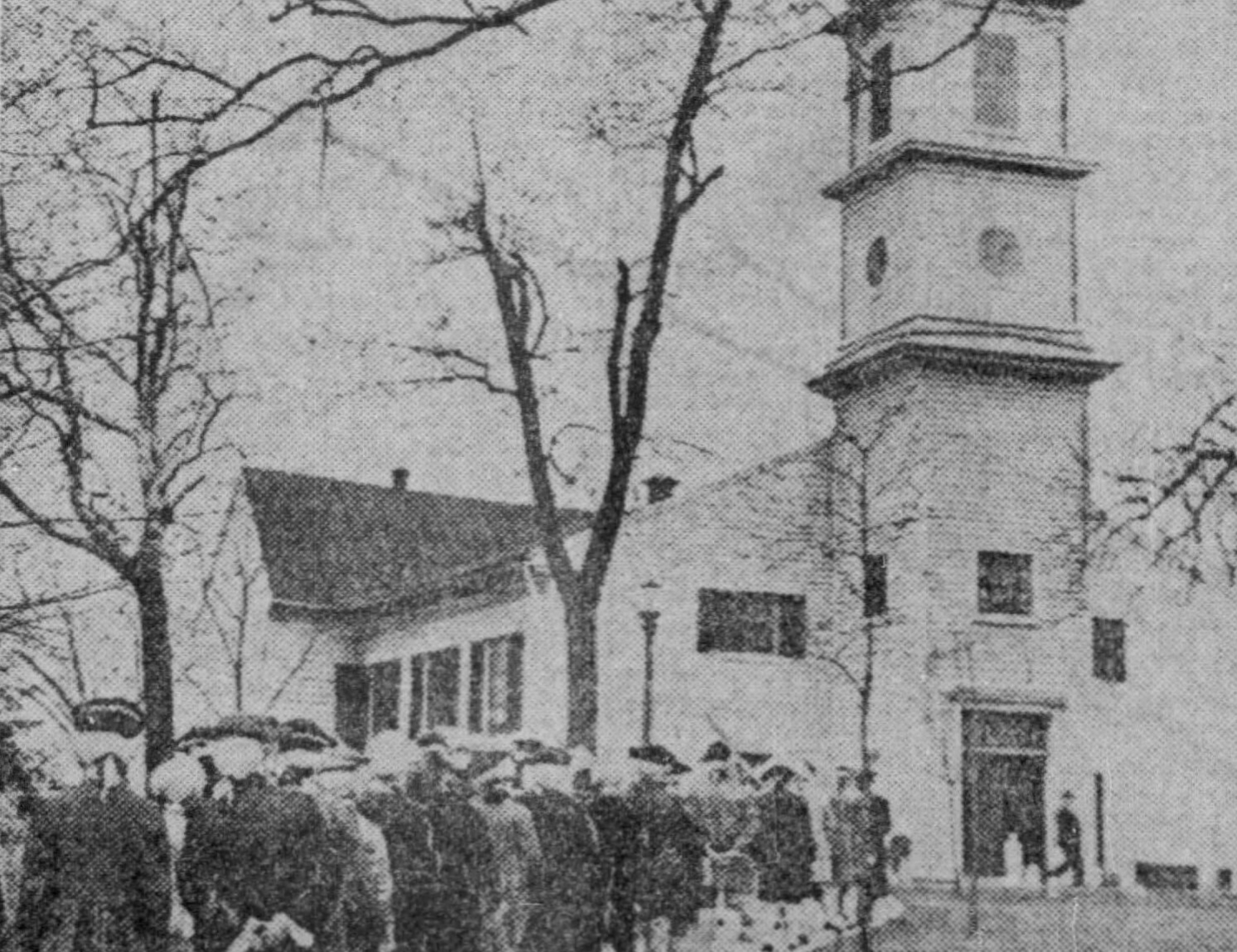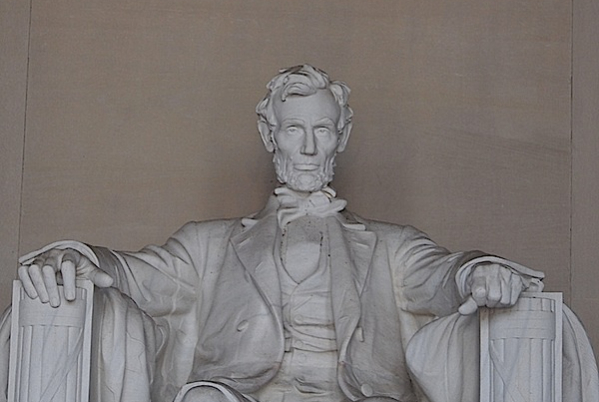One hundred and fifty-nine years ago this Sunday, a 26-year-old white supremacist and Confederate sympathizer named John Wilkes Booth pointed a .44 caliber derringer pistol at the back of Abraham Lincoln’s head and squeezed the trigger. The 56-year-old president clung to life for nine agonizing hours, expiring the next morning in a cramped room rented by Union veteran Willie Clark.
Lincoln’s death elevated a bigoted Democrat from East Tennessee, Andrew Johnson, to the presidency – and thereby changed the course of Reconstruction. Booth’s bullet pitched a nation still reeling from four years of fratricidal war – a conflict that had snuffed out the lives of nearly three percent of the U.S. population – into a moment of profound precarity.
Pundits are wont to deem our own present moment – wracked by dread, fear, and division at home and abroad – as somehow unprecedented. Historians, however, know that because everything has a history, nothing is truly new.
To be sure, the past, no less than our stormy present, must be understood on its own terms. Context is everything. But Lincoln’s assassination, the first shot of a violent counterrevolution to nullify Union victory and its consequences, offers up a compelling reminder that events whipsaw rather than rush in a single direction.
In the spring of 1865, the victors’ shouts of triumph in the streets faded quickly into wails of deep sadness.
In the ensuing weeks, communities yet trimmed in mourning ribbons welcomed home victorious Union soldiers. Toggling between triumph and tragedy proved profoundly disorienting for soldiers and civilians alike.
Still worse, Americans would soon realize just how narrowly they had escaped an even greater calamity than the one acted out on April 14, 1865. In the wake of the assassination, military and government officials quickly unraveled Booth’s conspiracy to topple the federal government.
Booth and his conspirators plotted to kill not only Abraham Lincoln but also Vice President Johnson, Secretary of State William Henry Seward, and Ulysses S. Grant, the hero of Appomattox and general-in-chief of all U.S. armies. The success of this conspiracy, of course, would have sparked a constitutional crisis since the Presidential Succession Act, establishing the order in which the various cabinet heads acceded to the presidency in the event of the vice-president’s incapacity, was still more than two decades (and yet another presidential assassination) away.
Levi Graybill, a 27-year-old Ohioan who captained a company of African American soldiers on the siege lines of Petersburg, could scarcely believe the news when it reached him on April 16. Only days before, his men had tramped triumphantly through the streets of Richmond, hastily evacuated by a Confederate government sent into exile. In the former rebel capital, Graybill’s soldiers participated in the “grand demonstrations” that cheered President Lincoln upon his arrival.
Now, the men received orders to report to Washington, D.C. to escort the martyred president’s body from the Executive Mansion to the Capitol rotunda. To commemorate this somber errand, Graybill purchased a likeness of the lamented Lincoln and sent it back home. “What a calamity to our nation,” Graybill exclaimed. “I thought the time for such things had passed. Are we drifting into Anarchy?”
Graybill’s fellow Ohioan Milton Barnes entertained similar questions as his regiment, grizzled veterans of the war’s western campaigns, marched north to Nashville, Tennessee. Upon receiving news of Booth’s vile crime, Barnes attempted to compose a letter to his wife, Rhoda, but found his pen uncharacteristically stilled.
“The emotions that crowded upon me were simply indescribable,” the soldier explained. “I had thought that the events of the last four years in our nation’s history were the greatest that had ever crowded themselves into the life of any nation or people, yet it seems we are not yet at an end.”
In recent, prize-winning books, historians Martha Hodes, Caroline E. Janney, and Elizabeth R. Varon have demonstrated how the fog of war still veiled the nation after Appomattox –obscuring any clear-eyed view of the future. Graybill, Barnes, and the men and women of their generation had no idea what the next day would bring, let alone how – or even if – the nation would survive. Just as there had been no manual for waging a civil war in a democratic republic, so too was their no manual for Reconstruction.
In their haste to impose order, our historical narratives too often effaced the messy realities of lived experience.
History can neither prescribe a remedy for what ails us nor assure us of any result. But it can remind us that we are hardly the first Americans to look to the future with a degree of disquietude.
Brian Matthew Jordan was a Pulitzer Prize finalist for his 2015 book “Marching Home: Union Veterans and Their Unending Civil War” and is a member of the Jack Miller Center’s scholarly network.
Share:
Related Posts

Continuing a Tradition of Civics Excellence
By Mike Sabo With new institutes emerging at colleges and universities in Florida, Ohio, Utah, Tennessee, North Carolina, Texas, and elsewhere, civics education may be

Give Me an Engaged Electorate
By John A. Ragosta On March 23rd in 1775, Patrick Henry rose at St. John’s Church in Richmond, Virginia, to urge his countrymen to arm

How Lincoln’s Assassination Changed American History
By Brian Matthew Jordan One hundred and fifty-nine years ago this Sunday, a 26-year-old white supremacist and Confederate sympathizer named John Wilkes Booth pointed a

Igniting an Appreciation for Abraham Lincoln in Children
By Jonathan W. White Historians and the general public regularly rank Abraham Lincoln as America’s greatest president. There is little doubt that he is widely

The Patriot Week Foundation achieved its 501(c)(3) status in December 2012 and has moved forward by building a sustainable, nonpartisan organization. Currently staffed with an Operations Manager and Education Consultant, the Patriot Week Foundation will be adding to its complement of talent shortly.
This unique, historically grounded, non-partisan approach is desperately needed in our toxic political environment. In no small measure, the fate of the nation depends on it.
Get in Touch
Fill out the form, our team will get back to you ASAP.
Copyright © 2021 Patriot Week

- All Episodes
Washington Crosses the Delaware — A Christmas Tale of 1776 (re-release)
Loading...
Thanksgiving - Origins, Meanings, Traditions, and Myths (Remastered)
Loading...
Presidential Elections - The Electoral College, Origins & Development (remastered)
Loading...
Presidential Assassinations, Resignations, and Disability - the 25th Amendment Revisited
Loading...
Declaration of Independence & July 4th - Background, Recitation
Loading...
Congress: Taxes & Taxing Power (Article I, Section 8 of the Constitution)
Loading...
Memorial Day (re-release of remastered episode)
Loading...
Lexington & Concord - The Shot Heard 'Round the World (re-release)
Loading...
Congress: Enumerated Powers - The Foundation of the Constitution, Art. I, Section 8
Loading...
Congress: Lawmaking, Bicameralism, Bills & Vetoes (Article I, Section 7)
Loading...
Washington Crosses the Delaware — A Christmas Tale of 1776 (Re-Release)
Loading...
Thanksgiving - Origins, Meanings, Traditions, and Myths (Re-Release 2023)
Loading...
Congress: Taxation/Money Bills/Revenue/Origination Clause
Loading...
Congress: Congressional Immunity & Prohibition from Plurality of Office Holding (article 1, section 6 of Constitution)
Loading...
Congress - Pay, Salary, & Compensation - Constitution Article I Section 6
Loading...
Declaration of Independence - Recitation & Background (2023)
Loading...
Congressional Elections & Organization
Loading...
Memorial Day - Origins, History & Meaning (Remastered)
Loading...
Congressional Elections - Time, Place, and Manner; Meetings of Congress
Loading...
Lexington & Concord - Shot Heard 'Round the World!
Loading...
US Senate II - Elections, Qualifications, Vice President, Organization, & Impeachment Power
Loading...
George Washington - Presidents Day Episode (Remastered)
Loading...
US Senate - The Divisive & Decisive Clash over Elections, Voting & Terms
Loading...
Washington Crosses the Delaware - A Christmas Tale of 1776 (remastered)
Loading...
Thanksgiving - Thanksgiving - Origins, Meanings, Traditions, and Myths - (Remastered 2022)
Loading...
Abraham Lincoln - An Interview
Loading...
3/5 Clause & Taxes, Number of Representatives, Speaker of the House, & Impeachment - House of Representatives Part - Part 3 (Article I, Section 2)
Loading...
July 4th, 1776 & the Declaration of Independence (slightly updated)
Loading...
Memorial Day - Origins, History & Meaning (replay)
Loading...
Three Fifths Clause, Census, Apportionment, House of Representatives - Part 2 (The Constitution Article 1, Section 2)
Loading...
Congress - Two Houses & the House of Representatives - Part 1 (The Constitution Article 1, Section 1-2)
Loading...
Washington Crosses the Delaware - A Christmas Tale of 1776
Loading...
Common Defense, General Welfare & Blessings of Liberty
Loading...
A More Perfect Union, Establishing Justice, and Ensuring Domestic Tranquility
Loading...
Thanksgiving - Origins, Meanings, Traditions, and Myths
Loading...
We the People - How the Constitution's Preamble Changed Everything
Loading...
Constitutional Convention Convened - Demi-Gods Meet in Philadelphia
Loading...
The Crisis - The Unraveling of America and Rights Threatened Post-Revolution
Loading...
Articles of Confederation - Text and Remarkable Achievements
Loading...
Articles of Confederation - Drafting & Ratification
Loading...
9/11: September 11, 2001 and its aftermath 20 years later
Loading...
Signers of the Declaration of Independence - Part 5
Loading...
Signers of the Declaration of Independence - Part 4
Loading...
Thomas Jefferson's Declaration of Independence - Comparing Jefferson's draft to the final signed version
Loading...
Signers of the Declaration of Independence - Part 3
Loading...
Signers of the Declaration of Independence - Part 2
Loading...
Free & Independent States - the Declaration of Independence
Loading...
Signers of the Declaration of Independence - Part 1
Loading...
Lives, Fortunes, & Sacred Honor - The pledge of the signers of the Declaration of Independence
Loading...
Lexington & Concord - the Shot Heard 'Round the World - April 19, 1775
Loading...
Petitions Rejected - A Tyrant Revealed and the People of Great Britain Exposed as Enemies
Loading...
Slaves Revolts! American Indians, Convicts, & indentured Servants, plus Impressment
Loading...
War! Plundering Seas, Burning Towns, & Hessian Mercenaries
Loading...
Revoking Charters, Suspending Legislatures & Declaring Parliament Supreme
Loading...
Time for Revolution - When a Long Train of Abuses Invariably Evinces a Design of Absolute Despotism
Loading...
Juries suppressed, defendants shipped overseas, and the Canadian threat!
Loading...
Presidential Inaugurations - the Constitution, oaths, history, traditions, and speeches
Loading...
Impeachment Round 2 - The Extraordinary Second Impeachment of Donald Trump & the Constitution
Loading...
25th Amendment - Death, incapacity, and removal of the President and Vice President
Loading...
Taxation without representation & cutting off trade with the rest of the world
Loading...
Quartering troops, mock trials, standing armies, military superiority, & pretended Parliamentary legislation
Loading...
Immigration Halted, Justice & Judges Subverted, and Swarms of British Locusts (Remastered)
Loading...
Invasions, convulsions, dissolving and fatiguing legislatures, and halting westward expansion.
Loading...
Presidential Elections - The Electoral College, Origins & Development
Loading...
Our Enemy the King; his despotic refusal to assent to our laws
Loading...
Supreme Court Appointments - The Constitution, History, Tradition & Raw Politics
Loading...
Labor Day - Origins, Purpose & Corruption of a True American Holiday - and Beer!
Loading...
Revolution! The right to alter or abolish government.
Loading...
Limited Government, Absolute Power, & Democratic Tyranny
Loading...
The Social Compact - Key to a Just Government
Loading...
The Pursuit of Happiness - An Unalienable Right
Loading...
Liberty! An Unalienable Right
Loading...
Riots, Protests, and Mobs! An American tradition.
Loading...
Unalienable Right to Life
Loading...
Unalienable Rights
Loading...
COVID-19 Addendum: Michigan - Center of the Storm
Loading...
COVID-19 - Can they really do that?
Loading...
Equality
Loading...
Self-Evident Truths
Loading...
Nature and Nature’s God
Loading...
George Washington
Loading...
When in the course of human events
Loading...
The introductory sentence of the Declaration of Independence - “The Unanimous Declaration . . . .”
Loading...
Declaration of Independence - a full reading of the text - July 4th & Independence Day
Loading...
Impeachment! History & Today
Loading...
Welcome to our Preview Episode!
Loading...
Patriot Lessons: American History and Civics (Constitution, Declaration of Independence, etc.) (Trailer)
Loading...

